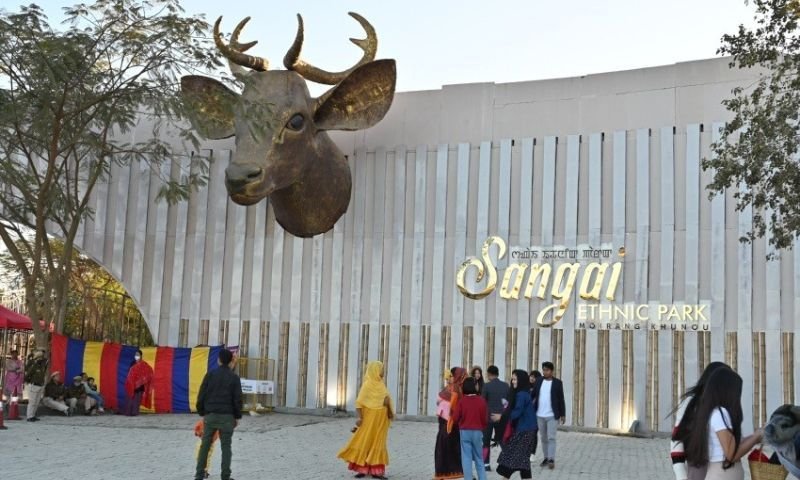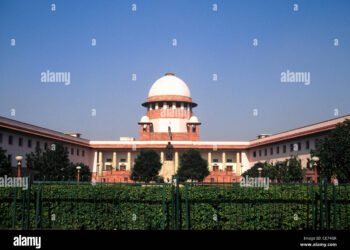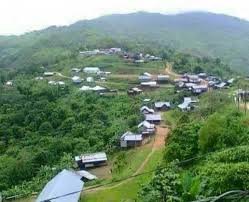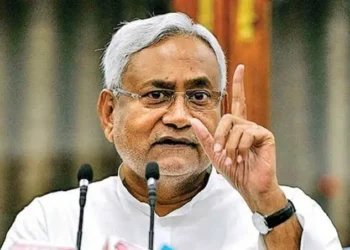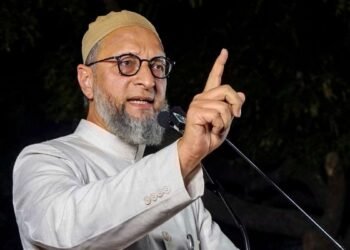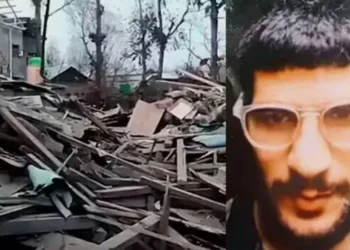With a mass sit-in set for November 20 and a shutdown on opening day, protesters argue the festival projects false normalcy while over 60,000 displaced persons continue to live in relief camps.
BY PC Bureau
November 19, 2025 — On the eve of what was intended to be the grand revival of one of Northeast India’s most iconic cultural showcases, Manipur stands sharply divided. The Sangai Festival 2025, set to run from November 21 to 30 after a two-year pause forced by ethnic conflict, is now engulfed in controversy. Major civil society organisations, led by the Coordinating Committee on Manipur Integrity (COCOMI), have called for a full-fledged boycott, describing the event as an “insensitive attempt at projecting normalcy” amid an ongoing humanitarian crisis.
A valley-wide sit-in protest has been announced for November 20, followed by a “cease-work, stay-at-home” strike on the festival’s opening day. The buildup has created palpable tension in the Imphal Valley and highlighted the widening gap between the government’s push for economic revival and the lived trauma of communities affected by more than two years of unrest.
A Festival of Culture and Tourism
For over a decade, the Sangai Festival has served as Manipur’s premier cultural extravaganza. Originally launched as the Manipur Tourism Festival, it was renamed in 2010 in honour of the endangered brow-antlered deer—locally known as the Sangai (Rucervus eldii eldii)—the state animal and a symbol of Manipur’s fragile ecological heritage.
Held annually from November 21 to 30, the ten-day festival traditionally transforms multiple venues across the Imphal Valley into hubs of cultural display. Hapta Kangjeibung and the Bhagyachandra Open Air Theatre host classical and folk performances such as Lai Haraoba, Thang-Ta martial arts demonstrations, and exhibitions of handloom textiles and bamboo crafts. Food courts offer local delicacies including Eromba and Singju, while adventure tourism peaks at Loktak Lake, famous for its floating phumdis.
The State Government urges all citizens to support and participate in the Sangai Festival 2025 (21–30 November), a celebration of Manipur’s resilience, culture and unity.
While the Government continues major efforts for relief and rehabilitation of IDPs, the festival serves as… pic.twitter.com/kmlAr8jXmP
— Government of Manipur (@govt_of_manipur) November 18, 2025
The festival also functions as a deliberate strategy to boost tourism and showcase the state’s biodiversity, indigenous sports, and heritage. Wildlife safaris at Keibul Lamjao—home to the world’s only floating national park—allow visitors to spot the Sangai deer alongside hog deer and migratory birds. Historical sites such as the INA Martyrs’ Memorial in Moirang add patriotic resonance to the itinerary.
Past editions have garnered international attention. Prime Minister Narendra Modi inaugurated the event in 2014, and President Ram Nath Kovind did so in 2017. The festival has historically provided crucial income to artisans, performers, and hospitality workers in a state whose economy is heavily reliant on tourism.
But after cancellations in 2023 and 2024 due to escalating ethnic violence, this year’s edition was positioned as a symbolic return to normalcy—an objective many now view as misplaced.
READ: What a mockery: Ajit Pawar’s son not named in land-deal report
READ: SC to Hear Plea on Hmar Youths Killing in Jiribam
Ethnic Conflict and Unresolved Grievances
The intensity of opposition to the festival is tied directly to the prolonged violence that erupted on May 3, 2023, when a Tribal Solidarity March by Kuki-Zo groups opposing the Meitei demand for Scheduled Tribe (ST) status triggered widespread clashes. The conflict revived longstanding valley-hill divides shaped by colonial administrative boundaries, land disputes, allegations of illegal immigration from Myanmar’s Chin State, and policies seen as favouring the valley-dominant Meiteis.
Within days, thousands were displaced as homes were torched and brutal attacks spread across regions like Churachandpur. The viral video of two Kuki women being stripped and assaulted in July 2023 shocked the nation. By mid-May that year, at least 71 people had been killed. Curfews, internet shutdowns, and the deployment of over 10,000 troops failed to restore normalcy.
Militia groups such as the Meitei Arambai Tenggol were reported to have looted over 6,000 weapons by late 2023, while Kuki volunteers fortified villages with bunkers. Over 400 churches and 132 temples were destroyed. As of November 2025, official counts place the death toll at 258, with more than 1,000 injured and 60,000 people living in 280 relief camps, though civil society and church groups believe the real figures could be higher.
Highway blockades continue to disrupt essential supplies. In February 2025, fresh clashes led to the resignation of Chief Minister N. Biren Singh and the imposition of President’s Rule. Kuki groups persist in demanding a separate Union Territory—a move repeatedly opposed by both the central government and Meitei bodies such as COCOMI.
Meanwhile, an estimated 15 lakh residents remain affected by restricted mobility, economic collapse, and psychological trauma. Monthly state expenditure on IDP relief has crossed ₹18 crore under a ₹523-crore central package, even as tourism remains decimated.
COCOMI’s Boycott Call
COCOMI—an umbrella comprising over 55 Meitei organisations—has been vocal since the early days of the conflict, advocating for territorial integrity and Meitei interests. On November 14, the group issued a formal call to boycott the Sangai Festival, describing it as “insensitive and unacceptable” at a time when thousands remain displaced and security remains fragile.
COCOMI convenor Khuraijam Athouba criticised the government’s decision to go ahead with the event:
“The festival is not for the people; it is an event for administrators and those seeking financial gain.”
Athouba said the government was using the festival to project “illusory normalcy” despite persistent blockades and unresolved IDP rehabilitation issues. He also questioned the granting of Protected Area Permits to foreign tourists amid domestic insecurity.
COCOMI’s stance has been supported by six IDP groups from conflict-hit areas including Moreh and Churachandpur, who on November 17 demanded complete cancellation of the festival. The committee rejected a last-minute meeting proposed by Chief Secretary Vineet Kumar Goel, citing inadequate notice and lack of clarity on the agenda.
Protests and Escalation Fears
COCOMI’s protest strategy appears well coordinated. A mass sit-in is scheduled across the valley on November 20, followed by a complete shutdown the next day. Residents have been urged to refrain from attending any festival activities and to organise locality-level protests with banners announcing non-participation.
IDP leaders have warned of “intensified agitation” if the government proceeds, raising concerns of renewed unrest. On Monday night, Governor Ajay Kumar Bhalla held a closed-door meeting with MLAs and senior officials, seeking support to ensure a peaceful festival.
Government Stands Firm Amid Political Pushback
The administration—currently functioning under central oversight—has shown no indication of postponing or cancelling the festival. Chief Secretary Goel issued an open appeal on November 19 urging all stakeholders, including IDPs, to support the festival as a “symbol of hope, opportunity, economic growth, and unity.”
Officials argue that reviving tourism is essential to restoring livelihoods and rebuilding confidence. Preparations continue, with international performers confirmed, venue upgrades nearing completion, and enhanced security arrangements in place.
Political reactions have been mixed. The Manipur Pradesh Congress Committee (MPCC) has expressed support for internally displaced people (IDPs) and civil society groups opposing the state government’s plan to hold the Sangai Festival from November 21.
The party said that hosting a major celebration while thousands of displaced families continue to struggle in relief camps would be “insensitive and misplaced.”
MPCC president Keisham Meghachandra said that, despite repeated assurances from the government, there has been little concrete progress in rehabilitating those uprooted by the state’s prolonged conflict. He urged the administration to focus on restoring peace and ensuring meaningful resettlement rather than pushing ahead with festivals at a time when many citizens “are still living in pain and uncertainty.”
This stance adds pressure on the BJP-led coalition and deepens political divides over the festival.
Economic Stakes
The boycott poses significant economic risks for a state with few industries and heavy reliance on tourism. Past editions of the festival attracted lakhs of visitors, but fear and instability now deter even local attendance. For many Meiteis, the Sangai Festival is a cultural emblem, making the boycott a painful decision driven by frustration with governance lapses.
Beyond immediate economic implications, the standoff highlights deeper concerns about Manipur’s fragile peace architecture. With President’s Rule in force and Supreme Court monitoring ongoing relief and policing failures, events on November 21 may either open space for dialogue or deepen existing fractures.
As Manipur approaches November 20, uncertainty hangs heavy. The Sangai deer—graceful yet elusive in the mists of Keibul Lamjao—remains a potent symbol. This year, its namesake festival has become a flashpoint in a broader struggle between celebration and justice.


